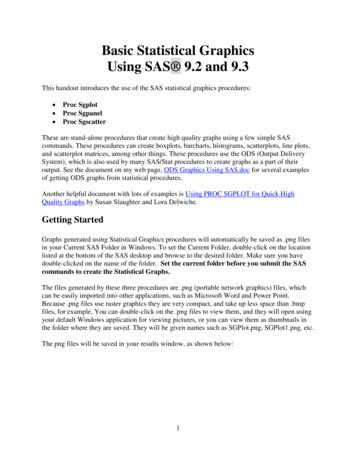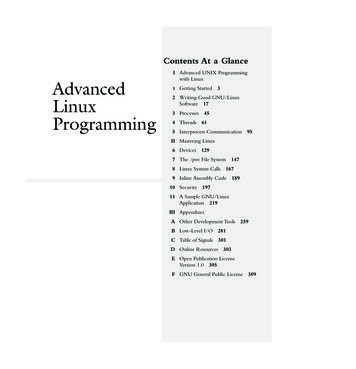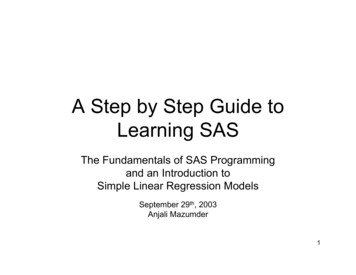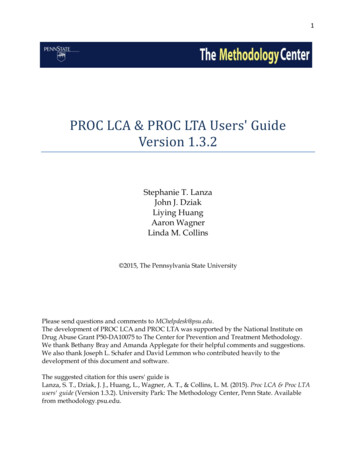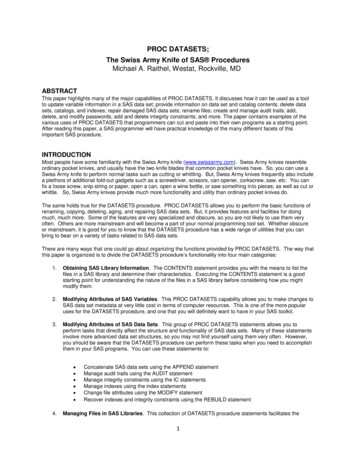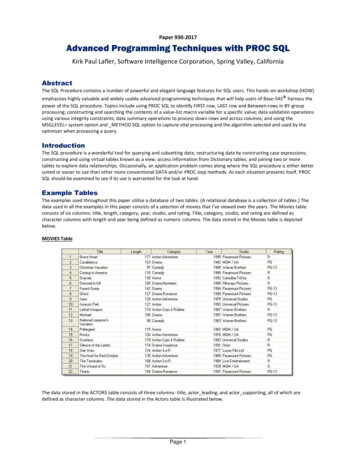
Transcription
Paper 930-2017Advanced Programming Techniques with PROC SQLKirk Paul Lafler, Software Intelligence Corporation, Spring Valley, CaliforniaAbstractThe SQL Procedure contains a number of powerful and elegant language features for SQL users. This hands-on workshop (HOW)emphasizes highly valuable and widely usable advanced programming techniques that will help users of Base-SAS harness thepower of the SQL procedure. Topics include using PROC SQL to identify FIRST.row, LAST.row and Between.rows in BY-groupprocessing; constructing and searching the contents of a value-list macro variable for a specific value; data validation operationsusing various integrity constraints; data summary operations to process down rows and across columns; and using theMSGLEVEL system option and METHOD SQL option to capture vital processing and the algorithm selected and used by theoptimizer when processing a query.IntroductionThe SQL procedure is a wonderful tool for querying and subsetting data; restructuring data by constructing case expressions;constructing and using virtual tables known as a view; access information from Dictionary tables; and joining two or moretables to explore data relationships. Occasionally, an application problem comes along where the SQL procedure is either bettersuited or easier to use than other more conventional DATA and/or PROC step methods. As each situation presents itself, PROCSQL should be examined to see if its use is warranted for the task at hand.Example TablesThe examples used throughout this paper utilize a database of two tables. (A relational database is a collection of tables.) Thedata used in all the examples in this paper consists of a selection of movies that I’ve viewed over the years. The Movies tableconsists of six columns: title, length, category, year, studio, and rating. Title, category, studio, and rating are defined ascharacter columns with length and year being defined as numeric columns. The data stored in the Movies table is depictedbelow.MOVIES TableThe data stored in the ACTORS table consists of three columns: title, actor leading, and actor supporting, all of which aredefined as character columns. The data stored in the Actors table is illustrated below.Page 1
Advanced Programming Techniques with PROC SQL, continuedSGF 2017ACTORS TableConstructing SQL Queries to Retrieve and Subset DataPROC SQL provides simple, but powerful, retrieval and subsetting capabilities. From inserting a blank row between each row ofoutput, removing rows with duplicate values, using wildcard characters to search for partially known information, andintegrating ODS with SQL to create nicer-looking output.Inserting a Blank Row into OutputSQL can be made to automatically insert a blank row between each row of output. This is generally a handy feature when asingle logical row of data spans two or more lines of output. By having SQL insert a blank row between each logical record(observation), you create a visual separation between the rows – making it easier for the person reading the output to read andcomprehend the output. The DOUBLE option is specified as part of the SQL procedure statement to insert a blank row and isillustrated in the following SQL code.SQL CodePROC SQL DOUBLE;SELECT *FROM MOVIESORDER BY category;QUIT;Removing Rows with Duplicate ValuesWhen the same value is contained in several rows in a table, SQL can remove the rows with duplicate values. By specifying theDISTINCT keyword prior to the column that is being selected in the SELECT statement automatically removes duplicate rows asillustrated in the following SQL code.SQL CodePROC SQL;SELECT DISTINCT ratingFROM MOVIES;QUIT;Using Wildcard Characters for SearchingWhen searching for specific rows of data is necessary, but only part of the data you are searching for is known, then SQLprovides the ability to use wildcard characters as part of the search argument. Say you wanted to search for all movies thatwere classified as an “Action” type of movie. By specifying a query using the wildcard character percent sign (%) in a WHEREclause with the LIKE operator, the query results will consist of all rows containing the word “ACTION” as follows.Page 2
Advanced Programming Techniques with PROC SQL, continuedSGF 2017SQL CodePROC SQL;SELECT title, categoryFROM MOVIESWHERE UPCASE(category) LIKE ‘%ACTION%’;QUIT;Phonetic Matching (Sounds-Like Operator *)A technique for finding names that sound alike or have spelling variations is available in the SQL procedure. This frequentlyused technique is referred to as phonetic matching and is performed using the Soundex algorithm. In Joe Celko’s book, SQL forSmarties: Advanced SQL Programming, he traced the origins of the Soundex algorithm to the developers Margaret O’Dell andRobert C. Russell in 1918.Although not technically a function, the sounds-like operator searches and selects character data based on two expressions: thesearch value and the matched value. Anyone that has looked for a last name in a local telephone directory is quickly remindedof the possible phonetic variations.To illustrate how the sounds-like operator works, let’s search each movie title for the phonetic variation of “Suspence” which,by the way, is spelled incorrectly. To help find as many (and hopefully all) possible spelling variations, the sounds-like operatoris used to identify select similar sounding names including spelling variations. To find all movies where the movie title soundslike “Suspence”, the following code is used:SQL CodePROC SQL;SELECT title, category, ratingFROM MOVIESWHERE category * ‘Suspence’;QUIT;Case LogicIn the SQL procedure, a case expression provides a way of conditionally selecting result values from each row in a table (orview). Similar to an IF-THEN construct, a case expression uses a WHEN-THEN clause to conditionally process some but not allthe rows in a table. An optional ELSE expression can be specified to handle an alternative action should none of theexpression(s) identified in the WHEN condition(s) not be satisfied.A case expression must be a valid SQL expression and conform to syntax rules similar to DATA step SELECT-WHEN statements.Even though this topic is best explained by example, let’s take a quick look at the syntax.CASE column-name WHEN when-condition THEN result-expression WHEN when-condition THEN result-expression ELSE result-expression ENDA column-name can optionally be specified as part of the CASE-expression. If present, it is automatically made available to eachwhen-condition. When it is not specified, the column-name must be coded in each when-condition. Let’s examine how a caseexpression works.If a when-condition is satisfied by a row in a table (or view), then it is considered “true” and the result-expression following theTHEN keyword is processed. The remaining WHEN conditions in the CASE expression are skipped. If a when-condition is “false”,the next when-condition is evaluated. SQL evaluates each when-condition until a “true” condition is found or in the event allwhen-conditions are “false”, it then executes the ELSE expression and assigns its value to the CASE expression’s result. Amissing value is assigned to a CASE expression when an ELSE expression is not specified and each when-condition is “false”.In the next example, let’s see how a case expression actually works. Suppose a value of “Exciting”, “Fun”, “Scary”, or “ “ isdesired for each of the movies. Using the movie’s category (CATEGORY) column, a CASE expression is constructed to assign oneof the desired values in a unique column called TYPE for each row of data. A value of ‘Exciting’ is assigned to all Adventuremovies, ‘Fun’ for Comedies, ‘Scary’ for Suspense movies, and blank for all other movies. A column heading of TYPE is assignedto the new derived output column using the AS keyword.Page 3
Advanced Programming Techniques with PROC SQL, continuedSGF 2017SQL CodePROC SQL;SELECT TITLE,RATING,CASEWHEN CATEGORY ‘Adventure’ THEN ‘Exciting’WHEN CATEGORY ‘Comedy’THEN ‘Fun’WHEN CATEGORY ‘Suspense’ THEN ‘Scary’ELSE ‘’END AS TYPEFROM MOVIES;QUIT;In another example suppose we wanted to determine the audience level (general or adult audiences) for each movie. By usingthe RATING column we can assign a descriptive value with a simple Case expression, as follows.SQL CodePROC SQL;SELECT TITLE,RATING,CASE RATINGWHEN ‘G’ THEN ‘General’ELSE ‘Other’END AS Audience LevelFROM MOVIES;QUIT;Creating and Using ViewsViews are classified as virtual tables. There are many reasons for constructing and using views. A few of the more commonreasons are presented below.Minimizing, or perhaps eliminating, the need to know the table or tables underlying structureOften a great degree of knowledge is required to correctly identify and construct the particular table interactions that arenecessary to satisfy a requirement. When this prerequisite knowledge is not present, a view becomes a very attractivealternative. Once a view is constructed, users can simply execute it. This results in the underlying table(s) being processed. As aresult, data integrity and control is maintained since a common set of instructions is used.Reducing the amount of typing for longer requestsOften, a query will involve many lines of instruction combined with logical and comparison operators. When this occurs, there isany number of places where a typographical error or inadvertent use of a comparison operator may present an incorrectpicture of your data. The construction of a view is advantageous in these circumstances, since a simple call to a view virtuallyeliminates the problems resulting from a lot of typing.Hiding SQL language syntax and processing complexities from usersWhen users are unfamiliar with the SQL language, the construction techniques of views, or processing complexities related totable operations, they only need to execute the desired view using simple calls. This simplifies the process and enables users toperform simple to complex operations with custom-built views.Providing security to sensitive parts of a tableSecurity measures can be realized by designing and constructing views designating what pieces of a table's information isavailable for viewing. Since data should always be protected from unauthorized use, views can provide some level of protection(also consider and use security measures at the operating system level).Controlling change / customization independenceOccasionally, table and/or process changes may be necessary. When this happens, it is advantageous to make it as painless forusers as possible. When properly designed and constructed, a view modifies the underlying data without the slightest hint orimpact to users, with the one exception that results and/or output may appear differently. Consequently, views can be made tomaintain a greater level of change independence.Page 4
Advanced Programming Techniques with PROC SQL, continuedSGF 2017Types of ViewsViews can be typed or categorized according to their purpose and construction method. Joe Celko, author of SQL for Smartiesand a number of other SQL books, describes views this way, "Views can be classified by the type of SELECT statement they use and the purpose they are meant to serve." To classify views in the SAS System environment, one must also look at how theSELECT statement is constructed. The following classifications are useful when describing a view's capabilities.Single-Table ViewsViews constructed from a single table are often used to control or limit what is accessible from that table. These views generallylimit what columns, rows, and/ or both are viewed.Ordered ViewsViews constructed with an ORDER BY clause arrange one or more rows of data in some desired way.Grouped ViewsViews constructed with a GROUP BY clause divide a table into sets for conducting data analysis. Grouped views are more oftenthan not used in conjunction with aggregate functions (see aggregate views below).Distinct ViewsViews constructed with the DISTINCT keyword tell the SAS System how to handle duplicate rows in a table.Aggregate ViewsViews constructed using aggregate and statistical functions tell the SAS System what rows in a table you want summary valuesfor.Joined-Table ViewsViews constructed from a join on two or more tables use a connecting column to match or compare values. Consequently, datacan be retrieved and manipulated to assist in data analysis.Nested ViewsViews can be constructed from other views, although extreme care should be taken to build views from base tables.Creating ViewsWhen creating a view, its name must be unique and follow SAS naming conventions. Also, a view cannot reference itself sinceit does not already exist. The next example illustrates the process of creating an SQL view. In the first step, no output isproduced since the view must first be created. Once the view has been created, the second step executes the view, G MOVIES,by rendering the view’s instructions to produce the desired output results.SQL CodePROC SQL;CREATE VIEW G MOVIES ASSELECT title, category, ratingFROM MOVIESWHERE rating ‘G’ORDER BY movie no;SELECT *FROM G MOVIES;QUIT;Identifying FIRST, LAST and BETWEEN Rows in By-GroupsA technique that SAS programmers often need and find useful is the ability to identify the beginning and ending observation ina by-group. The DATA step creates two temporary variables for each BY variable: FIRST.variable and LAST.variable. Performingby-group processing to identify FIRST., LAST., and BETWEEN observations is a popular technique with SAS users. Unfortunately,PROC SQL users had no way to emulate this very important programming technique. So, after considerable research and 3years in development, I came up with a coding technique that can be used in PROC SQL to emulate this stalwart DATA steptechnique using a subquery. Although still under refinement, the following SQL code correctly identifies the FIRST.column andPage 5
Advanced Programming Techniques with PROC SQL, continuedSGF 2017LAST.column in by-groups, and is able to identify the BETWEEN.column rows too in SAS-SQL, and leading RDBMS vendors SQLimplementations (but needs some refinement). Here’s what the SQL code can do:1.2.3.Identify FIRST.column By-group rowsIdentify LAST.column By-group rowsIdentify BETWEEN.column By-group rowsIdentifying FIRST.column in by-groupsSQL ********//** ROUTINE.: FIRST-BY-GROUP-ROWS**//** PURPOSE.: Derive the first (min) row within **//**each by-group using a ****************/proc sql;create table first bygroup rows asselect rating,title,'FirstRow' as ByGroupfrom movies M1where title (select min(title)from movies M2where M1.rating M2.rating)order by rating, title;FIRST. ResultsIdentifying LAST.column in by-groupsSQL ********//** ROUTINE.: LAST-BY-GROUP-ROWS**//** PURPOSE.: Derive the last (max) row within **//**each by-group using a ****************/create table last bygroup rows asselect rating,title,'LastRow' as ByGroupfrom movies M1where title (select max(title)from movies M2where M1.rating M2.rating)order by rating, title;Page 6
Advanced Programming Techniques with PROC SQL, continuedLAST. ResultsIdentifying BETWEEN.column in by-groupsSQL ***************//** ROUTINE.: BETWEEN-BY-GROUP-ROWS**//** PURPOSE.: Derive not the first (min) row and not**//**the last (max) row within each By-group. **************/create table between bygroup rows asselect rating,title,min(title) as Min Title,max(title) as Max Title,'BetweenRow' as ByGroupfrom moviesgroup by ratinghaving CALCULATED min Title NOT CALCULATED max Title ANDCALCULATED min Title NOT TitleANDCALCULATED max Title NOT Titleorder by rating, title;BETWEEN ResultsPage 7SGF 2017
Advanced Programming Techniques with PROC SQL, continuedSQL **************//** ROUTINE.: CONCATENATE-FIRST-BETWEEN-LAST**//** PURPOSE.: Concatenate the results from the first **//**(min) row, between rows, and last (max) **//**row within each by-group, and *******************/create table first between last rows asselect rating, title, bygroupfrom first bygroup rowsUNION ALLselect rating, title, bygroupfrom between bygroup rowsUNION ALLselect rating, title, bygroupfrom last bygroup rows;select * from first between last rows;quit;FIRST., LAST. and BETWEEN ResultsPage 8SGF 2017
Advanced Programming Techniques with PROC SQL, continuedSGF 2017Exploring Dictionary TablesThe SAS System generates and maintains valuable information at run time about SAS libraries, data sets, catalogs, indexes,macros, system options, titles, and views in a collection of read-only tables called dictionary tables. Although called tables,Dictionary tables are not real tables. Information is automatically generated at runtime and each table’s contents are madeavailable once a SAS session is started.The contents from Dictionary tables permit a SAS session’s activities to be easily accessed and monitored through theconstruction of simple queries. This becomes particularly useful in the design and construction of software applications sincethe information can be queried and the results acted upon in a specific task such as in the allocation of filerefs or librefs.SAS users can quickly and conveniently obtain useful information about their SAS session with a number of read-only SAS dataviews called DICTIONARY tables. At any time during a SAS session, DICTIONARY tables can be used to capture informationrelated to currently defined libnames, table names, column names and attributes, formats, and much more. DICTIONARY tablesare accessed using the libref DICTIONARY in the FROM clause of a PROC SQL SELECT statement. The name of each DICTIONARYtable and view along with its purpose are presented below.DICTIONARY tablePurposeCATALOGSProvides information about SAS catalogs.CHECK CONSTRAINTSProvides check constraints information.COLUMNSProvides information about column in tables.CONSTRAINT COLUMN USAGEProvides column integrity constraints information.CONSTRAINT TABLE USAGEProvides information related to tables with integrity constraints defined.DICTIONARIESProvides information about all the DICTIONARY tables.EXTFILESProvides information related to external files.FORMATSProvides information related to defined formats and informats.GOPTIONSProvides information about currently defined SAS/GRAPH software graphics options.INDEXESProvides information related to defined indexes.LIBNAMESProvides information related to defined SAS data libraries.MACROSProvides information related to any defined macros.MEMBERSProvides information related to objects currently defined in SAS data libraries.OPTIONSProvides information related to SAS system options.REFERENTIAL CONSTRAINTSProvides information related to tables with referential constraints.STYLESProvides information related to select ODS styles.TABLE CONSTRAINTSProvides information related to tables containing integrity constraints.TABLESProvides information related to currently defined tables.TITLESProvides information related to currently defined titles and footnotes.VIEWSProvides information related to currently defined data views.Page 9
Advanced Programming Techniques with PROC SQL, continuedSGF 2017Displaying Dictionary Table DefinitionsA dictionary table’s definition can be displayed by specifying a DESCRIBE TABLE statement. The results of the statements andclauses used to create each dictionary table can be displayed on the SAS Log. For example, a DESCRIBE TABLE statement isillustrated below to display the CREATE TABLE statement used in building the OPTIONS dictionary table containing current SASSystem option settings.SQL CodePROC SQL;DESCRIBE TABLEDICTIONARY.OPTIONS;QUIT;SAS Log Resultscreate table DICTIONARY.OPTIONS(optname char(32) label 'Option Name',setting char(1024) label 'Option Setting',optdesc char(160) label 'Option Description',level char(8) label 'Option Location');Note: The information contained in dictionary tables is also available to DATA and PROC steps outside the SQL procedure.Referred to as SASHELP views, each view is prefaced with the letter “V” and may be shortened with abbreviated names.SASHELP views can be accessed by referencing the view by its name in the SASHELP library. Please refer to the SAS ProceduresGuide for further details on accessing and using dictionary views in the SASHELP library.Dictionary.COLUMNSRetrieving information about the columns in one or more data sets is easy with the COLUMNS dictionary table. Similar to theresults of the CONTENTS procedure, you will be able to capture column-level information including column name, type, length,position, label, format, informat, and indexes, as well as produce cross-reference listings containing the location of columns in aSAS library. For example, the following code requests a cross-reference listing of the tables containing the TITLE column in theWORK library. Note: Care should be used when specifying multiple functions on the WHERE clause since the SQL Optimizer isunable to optimize the query resulting in all allocated SAS session librefs being searched. This can cause the query to run muchlonger than expected.SQL CodePROC SQL;SELECT *FROM DICTIONARY.COLUMNSWHERE UPCASE(LIBNAME) ’WORK’ ANDUPCASE(NAME) ’TITLE’;QUIT;ResultsPage 10
Advanced Programming Techniques with PROC SQL, continuedSGF 2017Dictionary.TABLESWhen you need more information about SAS files consider using the TABLES dictionary table. The TABLES dictionary tableprovides detailed information about the library name, member name and type, date created and last modified, number ofobservations, observation length, number of variables, password protection, compression, encryption, number of pages, reusespace, buffer size, number of deleted observations, type of indexes, and requirements vector. For example, to obtain a detailedlist of files in the WORK library, the following code is specified. Note: Because the TABLE Dictionary table produces aconsiderable amount of information, users should consider specifying a WHERE clause when using.SQL CodePROC SQL;SELECT *FROM DICTIONARY.TABLESWHERE UPCASE(LIBNAME) ’WORK’;QUIT;ResultsPROC SQL and the Macro LanguageMany software vendors’ SQL implementation permits SQL to be interfaced with a host language. The SAS System’s SQLimplementation is no different. The SAS Macro Language lets you customize the way the SAS software behaves, and inparticular extend the capabilities of the SQL procedure. Users can apply the macro facility’s many powerful features using theinterface between the two languages to provide a wealth of programming opportunities.From creating and using user-defined macro variables and automatic (SAS-supplied) variables, reducing redundant code,performing common and repetitive tasks, to building powerful and simple macro applications, SQL can be integrated with themacro language to improve programmer efficiency. The best part of this is that you do not have to be a macro languageheavyweight to begin reaping the rewards of this versatile interface between two powerful Base-SAS software languages.Page 11
Advanced Programming Techniques with PROC SQL, continuedSGF 2017Creating a Value-list Macro VariableA list of values can be created by concatenating one or more values from a single column into one macro variable using the SQLprocedure.SQL CodePROC SQL;SELECT titleINTO :mtitle SEPARATED BY '*FROM moviesWHERE UPCASE(rating) 'PG';QUIT;%PUT &mtitle;'SAS Log ResultsCasablanca* Jaws* Poltergeist* Rocky* Star Wars* The Hunt for Red OctoberScanning a Value-list Macro VariableSelected values can be searched within a macro variable using a %SCAN function and the value used in a WHERE-clause.SQL Codeoptions symbolgen;proc sql;select title into :mtitle separated by '*from movies where rating 'PG';%let scanvar %scan(&mtitle,3,*);select title, ratingfrom movieswhere title "&scanvar";quit;'SAS Log ResultsSYMBOLGEN:Macro variable SCANVAR resolves to PoltergeistCreating a Macro Variable with Aggregate FunctionsTurning data into information and then saving the results as macro variables is easy with summary (aggregate) functions. TheSQL procedure provides a number of useful summary functions to help perform calculations, descriptive statistics, and otheraggregating computations in a SELECT statement or HAVING clause. These functions are designed to summarize informationand not display detail about data. In the next example, the MIN summary function is used to determine the minimum lengthmovie in the MOVIES table with the value stored in the macro variable MIN LENGTH using the INTO clause. The results aredisplayed on the SAS log.SQL CodePROC SQL NOPRINT;SELECT MIN(LENGTH)INTO :MIN LENGTHFROM MOVIES;QUIT;%PUT &MIN LENGTH;Page 12
Advanced Programming Techniques with PROC SQL, continuedSGF 2017SAS Log ResultsPROC SQL NOPRINT;SELECT MIN(LENGTH)INTO :MIN LENGTHFROM MOVIES;QUIT;NOTE: PROCEDURE SQL used:real time0.00 seconds%PUT &MIN LENGTH;97Building Macro ToolsThe Macro Facility, combined with the capabilities of the SQL procedure, enables the creation of versatile macro tools andgeneral-purpose applications. A principle design goal when developing user-written macros should be that they are useful andsimple to use. A macro that violates this tenet or consists of complicated and hard to remember macro variable names has littleapplicability to user needs and is typically avoided.When possible, macro tools should be designed to serve the needs of as many users as possible. They should contain noambiguities, consist of distinctive macro variable names, the avoidance of possible naming conflicts between macro variablesand data set variables, and not try to do too many things. This utilitarian approach to macro design and construction helps gainthe widespread approval and acceptance by users.Column cross-reference listings come in handy when you need to quickly identify all the SAS library data sets a column isdefined in. Using the COLUMNS dictionary table a macro can be created that captures column-level information includingcolumn name, type, length, position, label, format, informat, indexes, as well as a cross-reference listing containing the locationof a column within a designated SAS library. In the next example, macro COLUMNS consists of an SQL query that accesses anysingle column in a SAS library. If the macro was invoked with a user-request consisting of %COLUMNS(WORK,TITLE);, the macrowould produce a cross-reference listing on the library WORK for the column TITLE in all DATA types.SQL and Macro Code%MACRO COLUMNS(LIB, COLNAME);PROC SQL;SELECT LIBNAME, MEMNAMEFROM DICTIONARY.COLUMNSWHERE UPCASE(LIBNAME) ”&LIB” ANDUPCASE(NAME) ”&COLNAME” ANDUPCASE(MEMTYPE) ”DATA”;QUIT;%MEND COLUMNS;%COLUMNS(WORK,TITLE);ResultsThe SAS SystemLibraryNameWORKWORKPage 13Member NameACTORSMOVIES
Advanced Programming Techniques with PROC SQL, continuedSGF 2017Submitting a Macro and SQL Code with a Function KeyFor interactive users using the SAS Display Manager System, a macro can be submitted with a function key. This simple, buteffective, technique makes it easy to run a macro with the touch of a key anytime and as often as you like. All you need to do isdefine the macro containing the instructions you would like to have it perform, assign and save the macro call to the desiredfunction key in the KEYS window one time, and include the macro in each session you want to use it in. From that point on,anytime you want to execute the macro, simply press the designated function key.For example, a simple PROC SQL query can be embedded inside a macro. You will not only save keystrokes by not having toenter it over and over again, but you will improve your productivity as well. The following code illustrates a PROC SQL queryembedded within a macro that accesses the “read-only” table DICTIONARY.TABLES. The purpose of the macro and PROC SQLcode is to display a “snapshot” of the number of rows in each table that is currently available to the SAS System. Once themacro is defined, it can be called by entering %NOBS on any DMS command line to activate the commands.SQL and Macro Code%MACRO nobs;SUBMIT "PROC SQL; SELECT libname, memname, nobs FROM DICTIONARY.TABLES; QUIT;";%MEND nobs;To further reduce keystrokes and enhance user productivity even further, a call to a defined macro can be saved to a FunctionKey. The purpose for doing this would be to allow for one-button operation of any defined macro. To illustrate the process ofsaving a macro call to a Function Key, the %NOBS macro defined previously is assigned to Function Key F12 in the KEYS window.Once the %NOBS macro call is assigned in the KEYS window, you will be able to call the macro simply by pressing the F12function key. The partial KEYS window is displayed below to illustrate the process.KEYS eyscommand focus%NOBSPartial Output from Calling %NOBSThe SAS SystemLibraryName Member NameWORK ACTORSWORK CUSTOMERSWORK MOVIESWORK PG RATED MOVIESWORK RENTAL INFOPage 14Number ofPhysicalObservations133221311
Advanced Programming Techniques with PROC SQL, continuedSGF 2017PROC SQL JoinsA join of two or more tables provides a means of gathering and manipulating data in a single SELECT statement. A "JOIN"statement does not exist in the SQL language. The way two or more tables are joined is to specify the tables names in a WHEREclause of a SELECT statement. A comma separates each table specified in an inner join.Joins are specified on a minimum of two tables at a time, where a column from each table is used for the purpose of conne
Advanced Programming Techniques with PROC SQL, continued SGF 2017 . Page 5 . Types of Views . Views can be typed or categorized according to their purpose and construction method. Joe Celko, author of SQL for Smarties and a number of other SQL books, describes views this way, "Views c
